Reflections on Full Stage USA
Six years ago, New Dramatists in New York was able to realize an extensive commission-development-production initiative. Thanks to a generous grant from The Andrew W. Mellon Foundation, New Dramatists, the hallowed, sixty-five-year-old playwrights’ artistic home and laboratory, forged partnerships with an eclectic constellation of producing theatres or networks of producing theatres across the country to explore new models of play creation and production.

The project was dubbed Full Stage USA.
New Dramatists felt it could address these challenges by creating and disseminating new models for new work development and production, and by facilitating more open, effective collaborations between writers and producers.
The impetus for the program grew out of the expressed needs of the resident playwrights for more productions. There was widespread agreement that new play development within producing theatres had become increasingly dead-end and that the choices of new work nationwide were becoming homogenized. Furthermore, a growing divide existed between playwrights and artistic leaders or “gatekeepers.” They disagreed on what made a play “finished” or “ready.” They lacked shared terminology for the goals of development. The split was further exacerbated by playwrights’ lack of access to decision makers. With dwindling funding to individual artists and few ongoing relationships between theatres and playwrights (residencies, company playwrights, etc.), writers increasingly stood on the outside, economically dependent on theatres but disempowered by them. Additionally, many theatres that do have development or commissioning programs failed to produce the work they initiated. As a result, many fine plays by talented writers never reached an audience, or they lost immediacy in the lengthy gap between writing and production.
New Dramatists felt it could address these challenges by creating and disseminating new models for new work development and production, and by facilitating more open, effective collaborations between writers and producers. New Dramatists could create an experimental lab, serving as a bridge between our writers and the field.
According to Todd London, who was until recently the Artistic Director of New Dramatists, the idea took seed in a conversation with Children’s Theatre Company (Minneapolis) artistic director Peter Brosius as far back as 1998 in the lobby of The Kennedy Center.
These off-handed conversations evolved into an experimental project called Playground with the support of the Jerome foundation, a commission-to-production project that went through several three-year cycles and was ultimately reimagined as an eclectic national program. With the support of a Mellon grant, the more expansive Full Stage USA saw five playwrights, a composer, and theatres across the country collaborate and develop plays for production.
In an earlier Full Stage USA summary report prepared by Doug DeNatale and Erica Nagel, London elaborated on the partnership between New Dramatists and the theatres: “We felt that there might be some way for us to connect with theatres that would utilize the strength of New Dramatists with our flexible resources and the theatres’ experience about production and making the work real.”
At a final convening in early July 2014, participating playwrights and theatres got together with the staff of New Dramatists and representatives from the Mellon Foundation to reflect on the results of the collaboration, difficulties and successes encountered, insights and lessons gained, and what could be modeled and sent out into the world of American theatre at large.
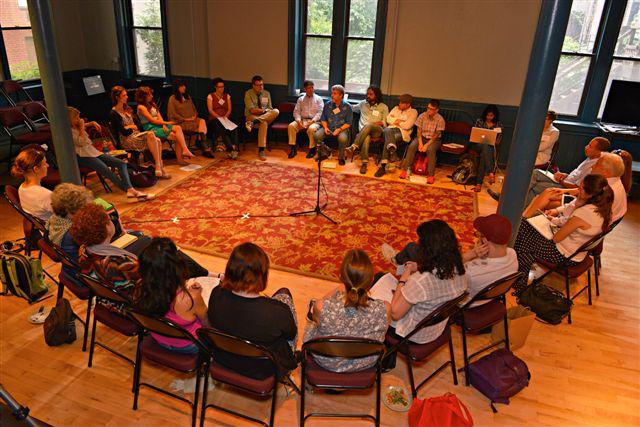
Background
Full Stage USA was an expansion of an initial model that was created in partnership with NYC theatres called Full Stage NYC, supported by Theatre Subdistrict Council and Time Warner. Both initiatives sought to give playwrights and theatres time to write and develop the work and make it possible to move the plays to production. In DeNatale and Nagel’s report, London explains the similarities and transitions between the two.
With Full Stage USA, the goal was to build on the Full Stage NYC program by increasing the size of the commissions, providing travel money for both the playwrights and the producing partners, providing financial support to the theatres for production, and offering more time to develop and complete the work, and assist in finding a second production for the project.
Full Stage USA took off when, after conversations with seventy-five theatres around the country, New Dramatists drew up a shortlist of thirty-five theatres of which three theatres, one community of theatres (Austin) and one network of twenty-seven theatres (NNPN) were finally chosen by a task force consisting of ND resident playwrights. The selections contained an eclectic mix of small, local theatres and larger companies. According to London, writers, undeterred by assumptions and big names, chose on the basis of deep artistic faith in the mission of the theatres:
The theatres were on the list because the writers felt strongly about them. It is strange to think about writers choosing theatres in our culture. In each case, they did it because they knew and believed in the theatre’s mission, of its deep and true development process, the communion of spirit, deep engagement, and its location within a community of great theatres. In every case, they chose and wanted to commit themselves to a theatre in acknowledgment of the beauty and compassion of its practices.
The five producing partners in Full Stage USA were selected for their representative range of the American theatre: from large scale regional powerhouses (Yale Rep, Oregon Shakespeare Festival) that wanted to take on equally large, demanding projects (a new musical, and a large scope show written for a substantial acting company, respectively); to innovative community based approaches to theatre production (the consortium of Austin, Texas, producers; Cornerstone Theater Company and its deep commitment to community partnerships); to a new model for new work development (National New Play Network and its promise for rolling world premieres and multiple productions across the country). This range of producers illustrated a valid experimentation base, against which the approach of artist-driven new work production would be tested, tweaked, and refined.
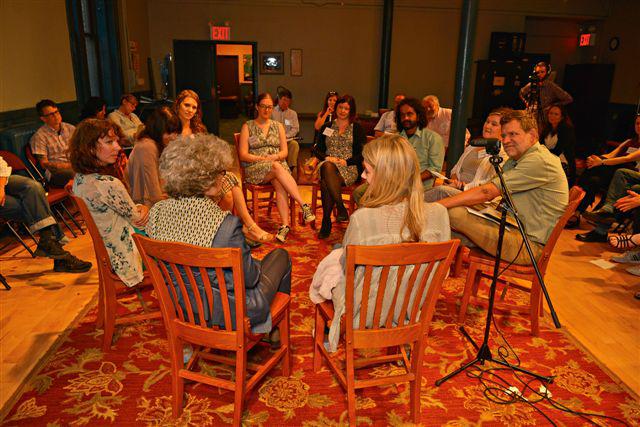
Jenny Larson, Shawn Sides, Jojo Ruf, Amy Boratko, Jennifer Kiger, Shishir Kurup,
Megan Wanlass, and David Dower. Photo by New Dramatists.
These theatres then chose five playwrights via an application process. In collaboration with the Austin based theatre makers, Sibyl Kempson developed her play, From the Pig Pile: The Requisite Gesture(s) of Narrow Approach. James McManus wrote Love on San Pedro for Cornerstone Theater’s Hunger Project. The National New Play Network selected Peter Sinn Nachtrieb to write The Totalitarians, which was then developed in collaboration with NNPN’s New Orleans member Southern Rep. Oregon Shakespeare Festival chose Stefanie Zadravec to write a new play, now entitled Colony Collapse, and playwright Carson Kreitzer and composer Matt Gould were selected to develop a new musical, Lempicka, with Yale Repertory Theatre.
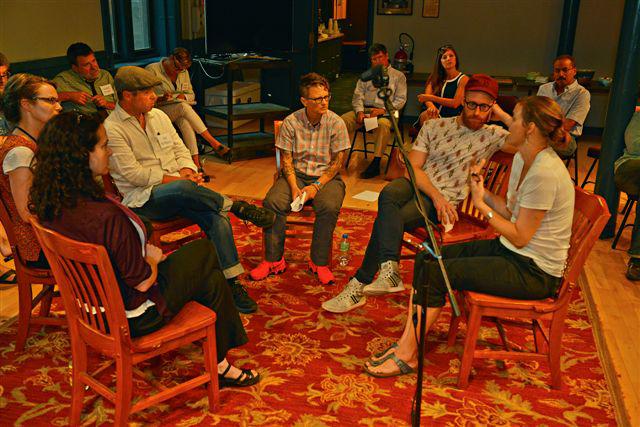
James McManus, P. Carl, Matt Gould, and Stefanie Zadravec. Photo by New Dramatists.
McManus’s play, Love on San Pedro, was staged in November 2013. Nachtrieb’s play, The Totalitarians—a buoyant, funny, and profound story of political candidacy in Nebraska received its first of three rolling premieres at Southern Rep in January 2014; it also completed a second run at DC’s Wooly Mammoth Theatre in June 2014, and is scheduled for its third production at Z Space, in San Francisco, November/December 2014. Kempson’s play was produced by Salvage Vanguard Theater in association with the Rude Mechs in April, 2014. Both Zadravec’s Colony Collapse, which she describes as a “big, complicated play with sixteen characters and still growing,” and Carson and Matt’s musical continue to be in development at OSF and Yale Rep respectively.
As some of the plays continue to be in progress, playwrights and theatres pondered the difficult chasm between development and production. “We wanted to let playwrights drive the process. Even if the theatre does not produce [the play], they will have a product that they can take anywhere else,” said John Steber, Director of the Playwrights’ Lab at New Dramatists. At the final convening, participants talked about the value of the three-year project for the field and its significant lessons for both playwrights and theatres.
Towards A New Relationship Between Theatres and Playwrights
The playwrights’ rationale for choosing the theatres they did made New Dramatists reevaluate its goals and the nature of the relationship between theatres and playwrights that came to define Full Stage USA. According to London:
In the New York process of electing theatres there was this huge turnaround moment. The impulse of this process was to educate theatres who do it badly by offering them incentives through our partnership. But our playwrights said we don’t want to do that. We want to reward theatres that already do this well, who treat us well.…I think this process has helped us move from a defensive posture into a place where we are all passionate, well-intentioned grown-ups. In that way New Dramatists has acted like a catalyst, a translator, and sometimes, a mediator.
In DeNatale and Nagel’s report, London explains, “We wanted to set a high bar for commissions by offering commissions of $25,000. And we were experimenting with the idea of enhancement money for production coming from a playwrights’ advocacy organization, rather than from the commercial theatre. If playwrights could come with money, as they are now often asked to do by theatres, what would that do to create certainty around production?”
Reflecting on the role of New Dramatists in the birth and facilitation of Full Stage USA, Jenny Larson, Artistic Director of Salvage Vanguard, points out, “New Dramatists was helpful for pushing against the gates. Risk becomes easier (for the theatre and playwright) when you feel supported.” According to Larson, New Dramatists’ vigorous advocacy of the artistic needs of playwrights corrected a traditional imbalance in the relations between a writer and a theatre.
Playwrights are usually like fish out of water. Theatre managers felt a little like fish out of water at New Dramatists and that was equalizing. As warm and welcoming as Austin can be it can feel like this is our turf in a way. To come here (New Dramatists) and be on Sibyl’s (Kempson) turf was really helpful. It helped to make sure that even though she is taking in information from forty different people in Austin, the process is centered on the idea that this is driven by Sibyl.
The value of the project as a response to the dearth of truly meaningful new plays on the American stage quickly became clear during the weekend conversations. Carson Kreitzer remarked on the tedium of watching plays that featured “four actors on a couch in a living room” over and over again.
As a New Dramatists playwright, I am a witness to amazing readings of plays and I am still waiting to see them on stage. All too often I see on stage the smaller or easier choice. I am frustrated to see fellow playwrights skew their work to what is producible. There is an echo chamber at work. [And] money for new musicals that are not based on a movie is so desperately needed.
Subsequently, the playwrights and projects chosen by the partner theatres were as far apart from each other as possible in terms of theme and execution.
Diverse Work On Diverse Stages
The partner choices were a deliberate attempt to foster aesthetic eclecticism and secure productions of diverse kinds of work on diverse stages. Subsequently, the playwrights and projects chosen by the partner theatres were as far apart from each other as possible in terms of theme and execution. They ranged from community responsive collaborations to avant-garde immersive theatre, from the tale of a venal Nebraska politician to an atmospheric drama of missing children and grieving parents, to an ambitious musical on the life of the early twentieth-century Polish painter, Tamara de Lempicka.
Playwrights spoke of the empowering validation and freedom that came with the commission and the reassurance of knowing that the theatres would move their plays from development to production. “To pay me what it actually cost to write a play changed everything. It raised the bar in a lot of different areas. I feel like I have credibility in the world that I never thought I would have,” said Kempson.
The hyper-collaborative nature of Pig Pile was described by Kempson as a “group effort” in which there were no clearly defined roles of producer, director, actor in the beginning and the text generated in the early stages “was one big compilation of associations and impulses and ideas and texts.” At the final convening for Full Stage USA, Kempson pointed out that the dynamic and heterogeneous manner of creating the play helped to root it in the Austin community as well as helped transform her perspective as an artist:
The way we went about making the piece taught me a tremendous amount about what happens when there is a group of people making something together in a chaotic way. There are no set rules, it is very confusing and frustrating; there are control issues, different agendas. Something about when it all comes together for a common purpose reminds me of David Byrne’s phrase, “a deeper order.” I witnessed a “deeper order.”

Photo by New Dramatists.
Kempson and her collaborators adopted the moniker “Pile of Pigs” to signify the community that had sprung up around the piece.
Jim McManus’s play was part of Cornerstone’s Hunger Project, a cycle of plays about hunger in Los Angeles. McManus focused on Skid Row’s community in downtown LA where 15,000 to 16,000 people live on the streets, in tents, or in single-room occupancies. The play was based on extensive interviews with Skid Row residents and close observation of their lives on the streets.
“I began the process with Cornerstone’s manager of community partnerships who found a number of nonprofits, guerilla organizations, corporate and religious organizations working in Skid Row. I ended up finding out very quickly the hunger they were talking about was not the food-driven hunger I thought I was going to write about,” said McManus. “It ended up being an opening of why they had come here and why they were living on the streets, some for twenty to twenty-five years. We would go to readings by guerilla organizations at 10 o’clock in the night or meet at the local Burger King,” adds McManus.
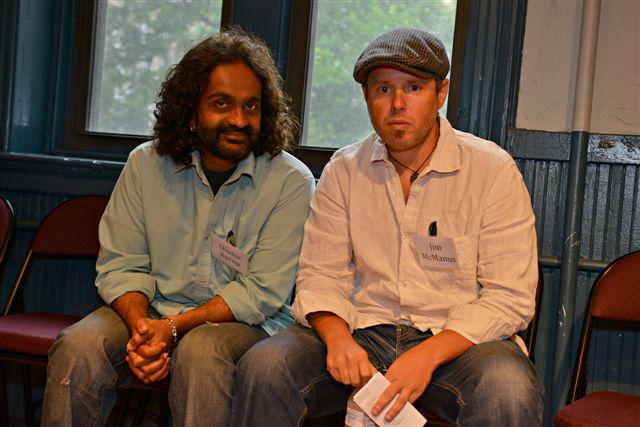
Shishir Kurup, who directed Love on San Pedro, became part of the meetings on Skid Row after the community partnerships manager left Cornerstone. The play was produced at the 150-seat LA Mission right in the heart of Skid Row. The final performance was oversold by forty to fifty people. Kurup says of the experience:
Part of the process is coming out with the first draft for a community reading—the community comes out and they give you feedback.…[W]hen we started doing the community readings we handed out parts and a number of folks couldn’t read. They were illiterate. When we did hold auditions so many of them had substance abuse problems that we wondered were they going to show up? Were they going to be able to emote? Do they know what it means to show up and give themselves over to a play and how that changes their lives? They did show up. They showed up for auditions and they showed up for rehearsals for the most part. That was amazing.
Lempicka has undergone a multifaceted development trajectory in which the playwright-composer duo has had numerous, intense workshop sessions in New Haven, New York, and Minneapolis. Associate Artistic Director Jennifer Kiger spoke of Yale Rep’s own unique learning experience through the process of commissioning, supporting, and developing a musical. “When you are working on a musical you just spend more time with Matt and Carson than we have spent with other commissioned artists. We learned so many lessons about working on musicals and developing musicals.”
What about the theatres themselves? Did theatres become more ambitious and expansive while working with a grant supported playwright? Larson from Salvage Vanguard pointed out that the grant for Kempson’s play brought together four different Austin theatres to collaborate and produce the play. Kurup of Cornerstone Theater reported, “Artistically it took us to Skid Row, which was not typical for us.” There was a great amount of variability in the development trajectory of the plays and each partnership between the theatre and the playwright used a variety of resources and development processes unique to the needs of the play. For the most part, what is unmistakable is that Full Stage USA instilled a tremendous sense of community through the nature of the alliances among playwrights, theatres, and New Dramatists.
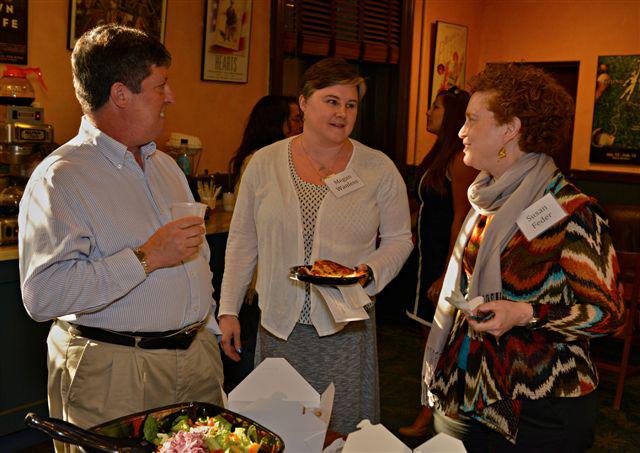
While production is at Full Stage USA’s core, the accretion of development processes for each play has been integral to the project’s taut structure.
Development Toward Production
While writers experienced a focused and driven journey toward production that impacted their working methods, the theatre partners articulated what it felt like to commit to production and follow through with it.
“If production is an undefined goal then that completely changes the relationship. We dated with Peter Nachtrieb. I thought we will be lucky if we are able to produce his play. It was about believing in the play and trusting that New Dramatists will be able to see us through,” said Aimée Hayes, producing artistic director of Southern Rep.
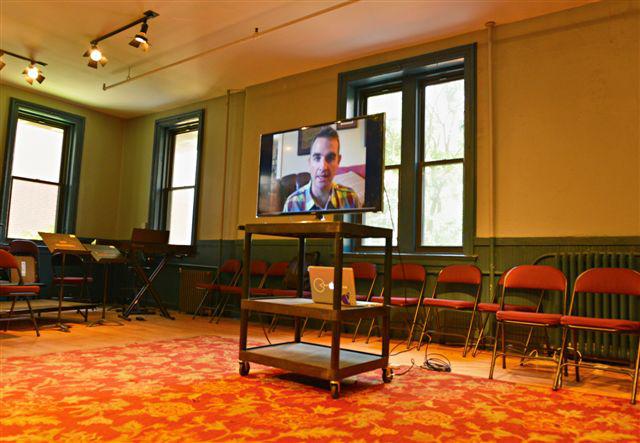
While companies like Salvage Vanguard and Cornerstone said they produce everything they commission, larger theatres such as Yale Rep and OSF have planned season cycles that may or may not align with the goals of Full Stage USA. Larson (Salvage Vanguard) and Kurup (Cornerstone) characterized their theatres as lighter entities with fewer stops between development and production “that can go guerilla and move quickly.”
According to Kiger, while Full Stage USA has not definitively set the template for production at Yale Rep, the theatre has been inspired to commit valuable resources to play development:
At Yale Rep we don’t guarantee production with the commission agreement. We had conversations early on if this is going to meet the mission of the Full Stage USA program. It is why we are challenging ourselves to do something bigger than we have done before…It was our goal that it will be created and it will have a life whether or not we put a production date on the commission. There is an element of funding that was to go towards supporting production and we put more resources in further developing it. The real question is should the funds be allocated to production or should they be allocated to the process of development so we can get it out there?
Writers were inspired and fueled by the close relationship between development and production, and approached the process of writing with an eye on official deadlines and completion, as well as the need to balance the needs of the play with that of production. While production is at Full Stage USA’s core, the accretion of development processes for each play has been integral to the project’s taut structure. Kempson shaped her play through initial informal showings, brainstorming workshops, and field trips with her collaborators, Kempson said,
Through those presentations it was as if the play was always in production, but it increased in formality as it went. Each time we learned more and more what the piece actually was. The production and process were always intimately linked. When we did the production finally in April it naturally felt like the culmination of all of those presentations.
Composer Matt Gould emphasized the emotional and financial significance of production for a theatre artist:
I am always thinking about the end game. There is a mantra in theatres to take your time. As an artist who doesn’t draw a salary, I can’t afford to take my time. The script for me always is a ticking clock. Ultimately, I want to get it produced, so I can pay my bills. There was a semi-promise of a production or the promise of the hope of production at some point. Yale was always honest with us. We still don’t know for sure if the play will be produced.
“I know with a rolling premiere that a play has a life, but it is the first production when you actually learn what your play is about. If you see three actresses ask the same question of a character then you realize it is not the actors, it is my writing. You don’t learn that until a production,” said playwright Stefanie Zadravec whose play is in development with OSF.

John Steber. Photo by New Dramatists.
The evolving relationships among commission, the writing process, and production have made it hard to ignore the “inevitable” objective that should ideally shape process-centered work in a playwrights’ lab. London thoughtfully formulates the importance of production to the playwriting process:
A part of me felt that we should be a laboratory and laboratory research should be pure research. And for years we have heard writers say we don’t want to dead end in development. We want it to lead somewhere. But there is something about this [Full Stage USA] I feel a little changed by. For Jim, Sibyl, and Peter there was something about really focusing on the inevitability of production. I think with Yale Rep and OSF the fact of the not knowing just brings in so much complication and emotional uncertainty… (though they have been really terrific processes and I have every faith they will lead to productions). I am more and more convinced that inevitability of production should be the heart of all research.
The Triangle of Playwright, Theatre, and New Dramatists
The trinity of writer, theatre, and New Dramatists created a propulsive alchemy, and both theatres and writers point out that in its role as facilitator, New Dramatists brought a deep knowledge for supporting development and of the challenges of producing theatre as well as thoughtfulness, flexibility, and rigor to the process of empowering playwrights.
“As an artist you are always aware of what a privilege it is to work with a theatre. I certainly feel a little like I am in their house. That’s the thing about New Dramatists—I feel this is our house. … It feels like we are able to approach this more as a collaboration,” said Kreitzer.
When John Steber asked Kempson about her play during one of her visits to New Dramatists it led to an artistic breakthrough. “John said to me let’s have a reading and let’s put actors around the table. Todd had the idea of including actors who were more dramaturgy-geared, because a lot of our time in Austin was about how are we going to do this because it is so complex and huge. I wasn’t really sure of the story I was telling.”
As the project progressed and grew in scope, some participants realized special attention was required for managerial transition between writer, lab, and theatre, as well as the management of expectations as the play moved through different phases of development. Lue Douthit, director of literary development and dramaturgy at OSF, mentioned that the fluidity around leadership of the project often left her unprepared to check in with the writer.
I always assumed New Dramatists was project manager until I realized I needed to be checking in. So the question for me is: who is the project manger and does the project manager know he or she is the project manager?
Smaller and hyper-local theatres were able to collaborate with playwrights they otherwise wouldn’t have been able to and almost all the participating theatres said the presence of New Dramatists helped them to learn to partner with an organization in a completely different way.
“Our partnerships with playwrights don’t generally start as commissions. They start as already written plays. … This partnership in many ways exploded that. Already we are having conversations with emerging writers about the ways we can not only incentivize productions but also guarantee productions. Part of it came about with this relationship with New Dramatists,” said Jojo Ruf, Associate Executive Director of NNPN.
Not surprisingly, the playwrights testified to the immense benefits of the duration of this partnership, which made time for multiple workshops and granted the physical and durational space for ambitious projects to take shape.
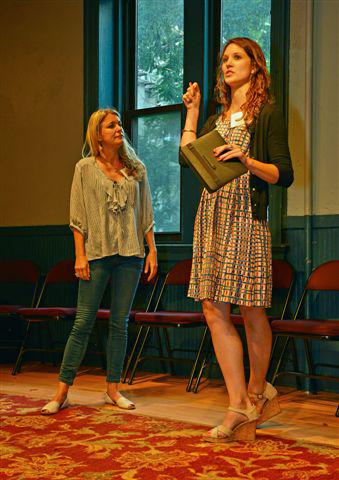
Photo by New Dramatists.
Ultimately, New Dramatists was a haven not just for playwrights but also for directors and dramaturgs from busy and large theatre companies who needed time away to focus on a commissioned play.
“New Dramatists is not fussy. Everybody is welcome to walk into the room and everybody seems to be on the same page. I really like that because I work in a fussy place. I want to get at the work at hand and put it in the middle of the room. Playwrights have a home here—it is their house. We are not at that point yet [at OSF]. One of the thrills of collaborating with New Dramatists was working with a new writer. Having somebody to hold both of our hands while we got to know each other has been thrilling,” said Douthit. Zadravec concurs about the value of having a home for workshops outside the commissioning theatre. “As we sorted things out, outside the parameters of theatre, Lue is as intimate with my play as I am. I love that. She has been in every workshop. She is the dramaturg. She is not directing it; she is not saying whether or not it will get produced. She just knows my play as well as I do.”
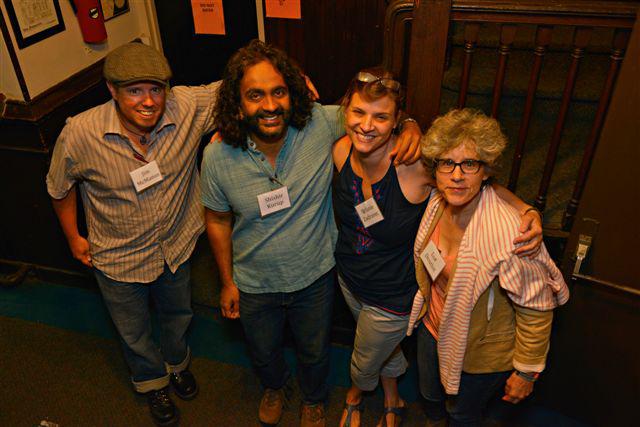
by New Dramatists.
The Richness of Time
Not surprisingly, the playwrights testified to the immense benefits of the duration of this partnership, which made time for multiple workshops and granted the physical and durational space for ambitious projects to take shape. New Dramatists and the theatres have shown a willingness to support workshops in multiple geographies and allot time and resources for them.
Kreitzer and Gould have had eight residencies and five workshops in Minneapolis, New Haven, and New York City. According to Kreitzer:
The really vital time in which this has been created has been the two of us in a room with a piano, a large table, index cards, stickies. That’s what we needed to create. But then there’s also time with performers. There’s a lot that goes into the quiet room where we can work for twelve hours at a stretch. Until I worked on this I hadn’t understood how much time it takes to hear your draft because Matt writes really complex music, I write complex scenes. But it is the music that takes this exponential amount of time and energy resources, so that we can hear what we have done. So that is a different kind of time.
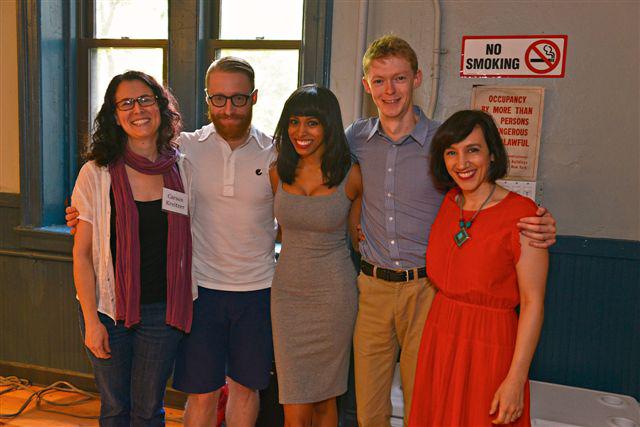
Gabrielle Stravelli. Photo by New Dramatists.
London pointed out that, “It feels like the two big kinds of time are duration time or extended time, and intense time. As we were talking about the musical earlier, part of what you need is compression time in the room to just work,” said London.
The assembled writers and directors talked about how a long duration had impacted the creation of their plays and the relationship it engendered with the local community. The latter was particularly true in the case of McManus’s and Kempson’s plays. “As time went on, we were able to put on these layers of work and form a deeply ingrained vocabulary that became its own mythology. The cast changed quite a bit from our work in progress last year to our production this year, and we watched how people got inducted into this crazy world that wasn’t the regular kind of play. We had made this universe with its own ecosystem, and I feel the time of our work together, the pace wouldn’t have been ordinarily possible,” said Kempson.
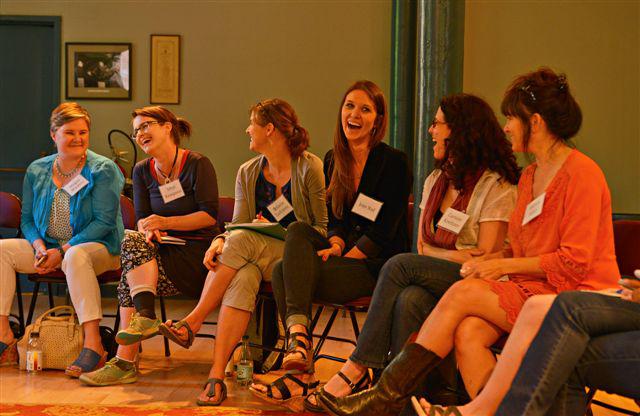
Photo by New Dramatists.
Items for Action
The highly eventful convening ended with a process lead by David Dower where the group collectively reflected on how this monumental project can be unspooled and its lessons distilled and shared within the community of American theatre. The question that kept arising was: How to replicate that sense of stability, home, and empowerment for playwrights when New Dramatists is not part of the equation? As someone wrote apropos of the playwriting experience during this session, “Goldfish grow bigger when given a bigger bowl in which to swim.” Given below are a few succinct and actionable items to consider in the process of deepening and enriching the writing, development, and production of new plays.
1. New Dramatists to reach out to advocates for playwrights among theatres in different cities from the pool of theatres that were initially shortlisted to partner with writers.
2. Playwrights to think of involving a supportive advocate playwright in the development partnership; another playwright who can be a resource for the development process. The idea is to involve more than one playwright in the development process even though a theatre is developing one playwright’s work.
3. For all constituents to consider different alliances so that in cases where there isn’t much funding or resources the process can be repeated. Possible alliances may include: the playwright, the big theatre, the service organization, the small theatre, or the playwright, the lab, the small theatre, the large theatre.
4. The group to consider offering mentorship for a possible next round in which playwrights can mentor other playwrights.
5. Constituents to consider a pipeline in which plays are carried further towards rolling premieres after the first production.
6. Constituents to consider how to build in an extension of this experience with colleagues in the field coming together. Plans are afoot to create an anthology that carries the plays of Full Stage USA. A convening is created for the workshop of a sixth possible project, so rather than nostalgia bringing the group back together for viewing a product, the convening experience becomes more about process.

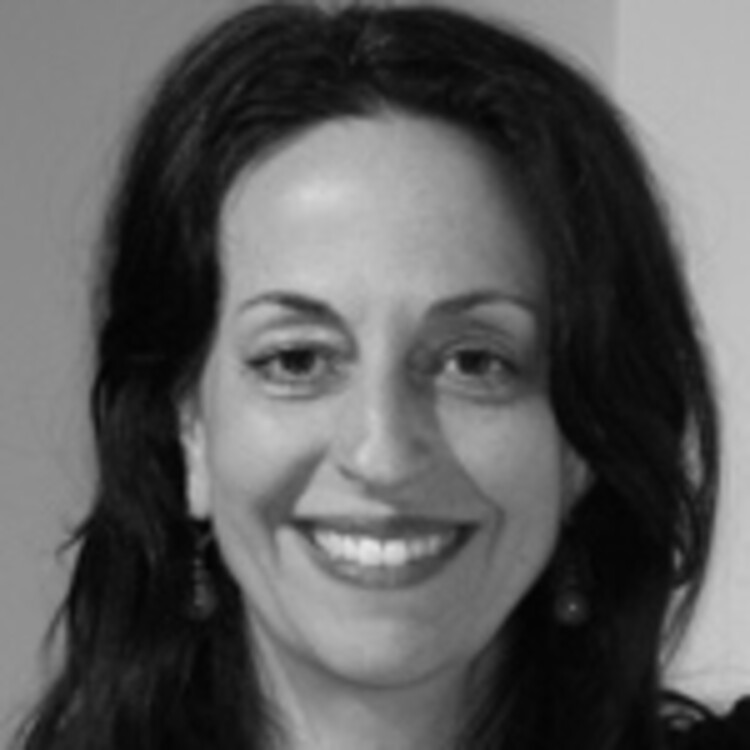

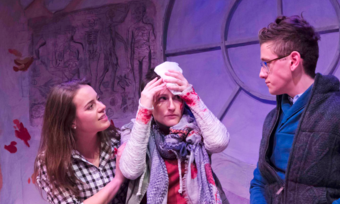





Comments
The article is just the start of the conversation—we want to know what you think about this subject, too! HowlRound is a space for knowledge-sharing, and we welcome spirited, thoughtful, and on-topic dialogue. Find our full comments policy here